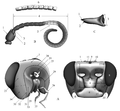Glossary of entomology terms

Parts of an adult butterfly
This glossary of entomology describes terms used in the formal study of insect species by entomologists.
A–C
- abbreviate(d)
- (adjective) Of an organ or member: markedly or unexpectedly short in proportion to the rest of the body
- posteriorof the thorax.
- abdominal feet
- See proleg
- Acalyptrata
- See Acalyptratae
- acanthus
- thorn-like projection, typically a single-celled cuticular growth without tormogen (socket) or sensory cells.[1]
- acaricide
- A chemical employed to kill and control mites and ticks.
- acariphagous
- feeding on mites (also refers to parasitoids of mites).
- accessory gland
- Any secondary gland of the glandular system.
- accessory pulsatile organs (APOs)
- Small muscular pumps and the veins that accompany them that pump hemolymph into the wings.
acetyl choline".- Alternative spelling of "acetylcholine
- acrostichal bristles
- The two rows of hairs or bristles lying one on either side of the mid-line of the thorax of a true fly.
- active space
- The space within which the concentration of a pheromone or other behaviorally active substance is concentrated enough to generate the required response, remembering that like light and sound pheromones become more dilute the further they radiate out from their source.
aculeate- (Hymenoptera) Any member of a group of families that include the familiar stinging ants, bees, and social and hunting wasp.
- acuminate
- Tapering to a long point.
- acylurea
- A class of insect growth regulators.
- adecticous
- Of pupa: the state in which the pupa does not possess movable mandibles, the opposite being decticous.
- adipocytes
- A major cell type of insects that stores fat body and reserves nutrients.
- admarginal
- (adjective): Along the margin.
- aedeagus
- The sclerotized terminal portion of the male genital tract that is inserted into the female during insemination. Its shape is often important in separating closely related species.
- aestivation
- Summer dormancy, entered into when conditions are unfavourable for active life i.e. it is too hot or too dry.
age polyethism- The regular changing of roles of colony members as they get older.
- air sac
- A dilated portion of a trachea.
- alar squama
- The middle of three flap-like outgrowths at the base of the wing in various flies.
- alary muscles
- Muscles along the dorsal diaphragm that may drive circulation.
- alata
- The parthenogenetic winged morph of vividae, specialized for migration.
- alate
- Winged; having wings.
- aldrin
A synthetic chlorinated hydrocarbon insecticide, toxic to vertebrates. Though its phytotoxicity is low, solvents in some formulations may damage certain crops. cf. the related Dieldrin, Endrin, Isodrin- algophagy
- Feeding on algae.
alitrunk- Name given to the thorax and propodeum of 'wasp-waisted' hymenopterans.
- Alloparenting
- When individuals other than the parent assist in the caring for that parents offspring. Alloparenting takes many forms, including castes in social insects raising the offspring of reproductives, and slave ant workers feeding the larvae of the slaver species.
- allopatric
- Two or more forms of a species having essentially separate distributions.
- alternating generations
- When two generations are produced within a life cycle each producing individuals of only one sex, either male first and then female or vice versa.
- altruistic
- Self-destructive. or potentially self-destructive behavior performed for the benefit of others.
- alula
- A broad lobe at the proximal posterior margin of the wing stalk of Diptera. Also termed the axillary lobe.
- ambrosia
- The fungus cultivated by wood-boring beetles of the family Scolytidae.
ametabola- Hexapods which develop without metamorphosis; namely the Protura, Thysanura, and Collembola.
- amide
- Compound derived from carboxylic acids by replacing the hydroxyl of the -COOH by the amino group, -NH2-.
- amine
- An organic compound containing nitrogen, derived from ammonia, NH3, by replacing one or more hydrogen atoms by as many hydrocarbon radicals.
- amino acid
- Organic compounds that contain the amino (NH2) group and the carboxyl (COOH) group. Amino acids are the "building stones" of proteins.
- ammonia
- A colorless alkaline gas, NH3, soluble in water.
- anal
- Pertaining to last abdominal segment which bears the anus.
- anal angle
- The posterior corner of the wing (same as tornus).
anal fold- A fold in the inner margin of the hindwing.
- anal valves
- Exposed claspers at the end of the abdomen.
- anaplasmosis
- Infection with Anaplasma, a genus of Sporozoa that infests red blood cells.
- anasa wilt
- A wilt disease of cucurbits caused solely by the feeding of the squash bug, no parasitic microorganism involved.
androconia- (singula = Androconium) In male butterflies, specialised wing scales (often called scent scales) possessing special glands which produce a chemical attractive to females.
androconiumor androconia (plural)- Specialised microscopic scales on the wings of male butterflies, believed to be scent scales for attracting the female.
annulate- Formed in ring-like segments or with ring-like markings.
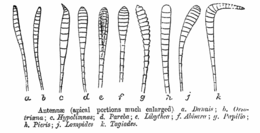 Butterfly antennae shapes
Butterfly antennae shapes- anemic
- Deficient in blood quantity or quality.
- anteclypeus
- the lower (anterior) portion of the clypeus of insects.
- antennae
- The long feelers situated on the head and close to the eyes. They are however not tactile but used for detecting airborne scents and currents.
- In Papilionoidea the antennae end in bulging tips called clubs.
- In Hesperioideathey have hooked tips and the club is found just before the tip.
- In some Lycaenidae like the genus Liphyra the antenna tapers gradually.
antennation- Touching with the antenna.
- antenniferous
- Bearing antennae, as in "antenniferous tubercle".
antennomereantennae, but it also may be used in referring to segments of odd sizes, shapes and functions, such as the scape and pedicel. More specific terms may be used where there are distinct antennal regions; for example flagellomeres are the antennomeres comprising the flagellum.- A segment of an antenna. The term antennomere is used in particular when the segments are fairly uniform, as in filiform
anterior- in front of or after the aforementioned structure.
- antenodal veins
- Small cross-veins at the front of the dragonfly or damselfly wing, between the wing base and the nodus.
- anthophagy
- feeding on flowers.
- antibiosis
- An association between two or more organisms that is detrimental to one or more of them.
- anticoagulin
- A substance antagonistic to the coagulation of blood.
- anus
- The posterior opening of the digestive tract.
- apex / apical area
- The anterior corner of the wing.
- apical cell
- The first posterior cell in the wing of Diptera. It is the space between the third and fourth longitudinal vein beyond the anterior crossvein (R5).
- aphidophagy
- feeding on aphids (and parasitoids of aphids).
- apitherapy
- Medicinal use of the honey bee or its products.
- arculus
- A crossvein between the radius and cubitus near the base of the wing in certain insects.
- areola
- 1. A small ring of color
- 2. In crayfish, the hourglass pattern on the dorsal surface of the cephalothorax
[2]- arolium
- A pad-like median lobe between the tarsal claws.
- base / basal area of wing
- Region close to the point of attachment to the thorax.
- basal streak (Noctuidae)
- also basal dash — a typically short and broad line at the mid-basal area of the forewing of noctuid moths.See figures 4, 5
- brand
- Raised area on the wing surface, circular, ovate, or elongated, which is covered with special scent scales or androconia, found in males of some species. Also called sex mark.
- bryophagy
- feeding on moss.
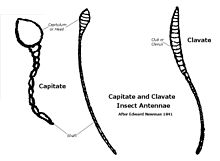
Distinction between clavate and capitate anatomy of insect antennae - capitate
- Mainly referring to antennae, but occasionally to other anatomical features such as palps: having a clubbed shape with a relatively long, slender stem, but with an abruptly bulkier, thicker, possibly globular distal head, the capitulum. The term capitate is not strictly distinguished from clavate, but where a distinction is desired, it is that the club of a capitate antenna is abruptly distinct from the shaft, and the head tends to be short and more or less globular. The club of a clavate antenna generally is a more or less tapered thickening, sometimes hardly distinct from the shaft.
- capitulum
- The head of a capitate structure, such as a capitate antenna, or of a capitate
haltere- carina
- a keel-like elevation (or ridge) on the body-wall of an insect.
- carpophagy
- feeding on fruits and seeds.
- catenulate
- Markings consisting of rings connected together like a chain.
- catenulated antennae
- Antennae with ringed appearance.
- cell
- The central area surrounded by veins. It can be closed by veins or open.
- The vein forming the boundary of the cell along the costal margin is known as the subcostal vein q.v.
- The vein forming the lower boundary towards the dorsum is called the median vein.
- In the case of butterflies, the cell is closed by a vein connecting the origins of veins 6 to 4 along the top of the cell which is known as discocellular vein.
- cell cup
- Taxonomically important term used in Diptera identification keys. Part of the schema of wing venation. Also called the posterior cubital cell and often called the anal cell. see File:Phytomyzinae wing veins-1.svg
- central shade or median shade
- Taxonomically important term used in moth description. It is a transverse band in the median area of the wing. See figures 4, 5
- ceratophagy (Also spelled keratophagy)
- feeding on cornified tissues and hair of animals.
- cervix
- (Anatomical feature) the structure defining the neck of the insect.
- chaeta
- See Seta.
- chaetosema
- patch of sensory bristles.
- chalaza
- An external spine that has a single point. Etymology: Greek chalasa, a tubercle. cf. scolus, which has multiple points.
- cheta
- See Seta.
- cilia
- Fine hairs along the edges of the wing.
- clasper or clasp
- A structure in male insects that is used to hold the female during copulation.
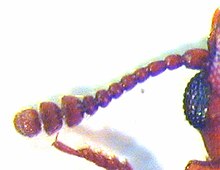
Clavate antenna of a beetle in the family Erotylidae. In this specimen the clavus comprises three segments - clava
- Same as clavus.
- clavate
- Mainly referring to antennae, but occasionally to other anatomical features such as palps: having a clubbed shape with a relatively long, slender stem, but with a bulkier, thicker distal end, the clava. The term clavate is not strictly distinguished from capitate, but in general, where a distinction is desired, the club of a capitate antenna is abruptly distinct, even globular, whereas the club of a clavate antennae is generally a more or less tapered thickening
- claviform stigma
- specifically, in Noctuidae (moths)- an elongate spot or mark extending from the anterior transverse anterior line through the submedian interspace, toward and sometimes to the posterior transverse line.See figures 4, 5
- clavola
- Same as clavus or club
- clavus
- 1. The thicker distal end of a clavate anatomical structure such as an antenna. Usually comprising more than one joint. Also called clava, clavola, or club
- 2. The posterior of the portion of the remigium found on insect wings.
- 3. The oblong sclerite at the base of the
hemelytron in Heteroptera.- 4. The knob at the end of the stigmal or radial veins in the wings of certain Hymenoptera.
- club
- The popular (possibly to be preferred) name for the clavus of a clavate antenna.
- clypeus
- (Anatomical feature) a sclerite structure below the frons, circumposed by the mandibles and above the labrum.
- coccidophagy
- feeding on scale insects (and parasitoids of scale insects).
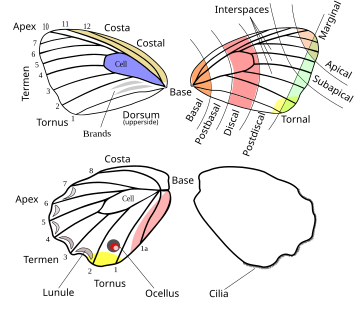 Terms associated with the wings
Terms associated with the wings- compound eye
- An eye consisting of a large number of individual photoreceptor units or ommatidia (ommatidium, singular).Figure 2 d below
- connexivum or connexiva (plural)
- (largely in Heteroptera and similarly dorsoventrally flattened insects) the edge of the abdomen, containing the connection between the tergite and sternite. May be visible from above in species such as many of the Reduviidae.
- copromycetophagy
- inhabiting feces and consuming mycetes growing inside or cultivating them for feeding.
coprophagy- feeding on the excrements of animals.
- costa / costal area
- The leading edge of the wing.
- costal break
- Taxonomically important term used in Diptera identification keys. Part of the schema of wing venation. weakenings of the costa (one to three in number). They are flexing points for the wings during flight
- costal fold
- A fold in the leading edge of the forewing of Lepidoptera, containing androconia.
- coronal suture
- (Anatomical feature) an anterior suture line of the head between the compound eyes, below the median ocellus.
- coxa
- first leg segment, between body and trochanter.
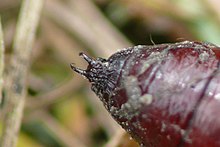
Cremaster of pupa of the oak owl moth, Griposia aprilina - cremaster
- A general term for a structure by which an object hangs (from Greek language kremastos, meaning "hung up"); for example in entomology:
in some Lepidoptera, including most butterflies, the pupa attaches to a surface by the cremaster, a structure at the tip of the pupal abdomen. The cremaster is the homologue of the anal plate of the caterpillar. It takes various forms in different species, ranging from a simple point, to various arrangements of hooks that catch Velcro-like in a silken pad that the caterpillar spins on the surface before it enters the prepupal phase.- crenulate
- Adjective = scalloped. Describes the outer edge of a wing that is convex at the end of each vein and concave in between.
- cuneus
- Noun =
hemelytra(forewings), located at the apex of the thick, leathery part of the wings.
Staphylinidae
are markedly abbreviate.D–F
- decticous
- Functional mandibles present in pupal state.
- dendrophagy
- feeding on trees.
- dentate
- As for crenulate but with the projections at the end of each wing being toothlike.
- detritophagy
- feeding on ground remains of plants and animals.
- dieldrin A synthetic chlorinated hydrocarbon insecticide, toxic to vertebrates. cf. the related Aldrin, Endrin, Isodrin
- disc / discal area
- The central band passing through the cell.
- discoidal cell
- In damselflies (wing venation, which is delimited by veins MA (anterior side), MP (posterior side), MAb (distal side) and the arculus (basal side).
- dorsum/ dorsal area
- The trailing edge or hind-margin of the wing, extending from the base to the tornus. Dorsal alternately, also refers to the back, i.e. the upper part of the body, from above.
- ectognathous
- (Anatomical feature) having exterior mouthparts, or exposed. A defining feature of insects.
- elytron
- (Anatomical feature) the modified, hardened forewing of certain insect orders, notably beetles (Coleoptera) and some of the true bugs (Hemiptera).
Cerambycidae
with conspicuous emargination of the compound eye (black) where it extends partway round the base of the antennaepicranius
caudal filament resembling the two cerci that flank it. In the Odonata epiprocts have various functions, both in larvae, in which they may have respiratory roles, and in adults, in which they may have reproductive roles. Not all epiprocts in all insect species are homologous. Note that the term is used in other groups than insects as well, for instance Myriapoda
.

Larva of a species in the family Sphingidae. The large eyespots on the back have no function concerning vision at all; when threatened, the caterpillar retracts its head, leaving the spots resembling either a threat, or as a more tempting target than the vulnerable head. The stemmata are visible as an arc of about four tiny spots slightly lateral to, and above the mouthparts. They are inconspicuous and do have a visual function.
frons(Anatomical feature) The frontal area of an insect's head. It covers the upper part of the face above the clypeus and below and between the antennae
. It supports the pharyngeal dilator muscles and usually bears an ocellus.
G–L
- gena
- (Anatomical feature) the area below the compound eyes, the insect equivalent to human cheeks.
- geniculate
- Elbowed. From the Latin for a bended knee, referring to an organ of a type not always expected to be kinked, but having a definite angular bend or hinge. In entomology the term typically refers to an elbowed antenna. For instance, many species of Hemiptera, Coleoptera, and Hymenoptera have markedly geniculate antennae
- girdle
- a strand of silk used to prop up the pupa. Found especially in the Papilionidae.
- glabrous
- smooth, without hairs or scales.
- gula
- ventral head sclerite which supports the submentum
- helminthophagy
- feeding on worms classified with helminths(including parasitoids of helminths).
- hemocoel
- the interior of the insects anatomy, including all organs and hemocyte.
- hemocyte or haemolymphof insects containing nutrients, fat, water, etc.
- a fluid in the circulatory system
hemophagy- feeding on blood.
- herbiphagy
- feeding on herbaceous plants.
- hindwing
- (Anatomical feature) the pair of wings of a four-winged insect farthest from the head.
- hyaline
- transparent, like glass.
- hygropetric
- mode of life: living in the thin film of water on wet rocks.
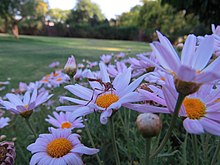 A fly in the family Vermileonidae, using its hypognathous proboscis to extract nectar from florets.
A fly in the family Vermileonidae, using its hypognathous proboscis to extract nectar from florets.- hypognathous
- having mouthparts that are ventrad of a vertically oriented head, "pointing downwards", or having an "under bit", instead of pointing backwards or forwards.
- hypopharynx
- Mouthpart. A tonguelike lobe on the floor of the mouth.
oviposition.- imago
- (plural is usually imagines) The final, or adult, stage in metamorphosis.

Coreidae: adult male Anoplocnemis with incrassate posterior femur - incrassate
- localised thickening of a member such as an antenna or leg.
- interspace
- The region between adjacent veins.
- irrorated or irroration
- Old term used usually to indicate a sprinkling of scales interspersed among scales typically of a different color.
- Isodrin
A synthetic chlorinated hydrocarbon insecticide, toxic to vertebrates. Though its phytotoxicity is low, solvents in some formulations may damage certain crops. cf. the related Dieldrin, Aldrin, Endrin- keratophagy (Also spelt ceratophagy)
- feeding on cornified tissues and hair of animals.
koinobiont- A form of parasitoidy where the parasitoid lives inside the host while allowing it to live after oviposition.
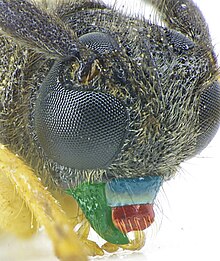 Head of a beetle in the family Cerambycidae; showing the labrum in red, below the clypeus in blue
Head of a beetle in the family Cerambycidae; showing the labrum in red, below the clypeus in blue- labium
- Mouthpart forming the lower lip. Bears the labial palps.
- labrum
- (Anatomical feature) the anterior structure below the clypeus covering some of the mouthparts, sometimes called the "upper lip".
 Diagram of an insect leg
Diagram of an insect leg- lichenophagy
- feeding on lichens.
- lines (moth)
- transverse line markings on the wings of moths, mainly Noctuidae- basal line; inner line; outer line; submarginal line.See figures 4, 5
- lines of weakness
- (Anatomical feature) the suture lines where the integument will split to allow for molting or autotomy.
- lunule
- A body area or marking roughly in the shape of a crescent.

A "true" bug, order Hemiptera, with geniculate antennae
M–O
- macrochaete
- large bristles and scales.[3]
- elytra, as long, or longer than the abdomen.
- malacophagy
- feeding on mollusks (and parasitoids of mollusks).
- maxilla
- Mouthpart. The maxillae are paired and arranged behind the mandibles. May bear palps. See Figures 1 and 3.
- membranule
- a small triangular opaque region at the base of the hindwing in some dragonflies.
- mesothorax
- the middle segment of the thorax, between the prothorax and the metathorax.
- metalmarks
- small metallic-looking spots commonly found on the wings of Riodinidae.
- metathorax
- The third and last segment of the thorax after the mesothorax.
elytra, shorter than the abdomen.- mixomycetophagy
- feeding on myxomycetes slime molds.
- myiasis
- Infestation of fly larvae on or in a vertebrate host.
mycetophagy- feeding on fungus.
necrophagy- consuming of dead animals and their remains.
- nervure
- Older term for vein. adnervural refers to instance lines running adjacent and alongside the veins.
- nodus
- (of Odonata ) A prominent cross-vein near the center of the leading edge of a wing. Also called "node".
- obtect
- Appendages fused or glued to the body.
- occipital suture
- (Anatomical feature) the structure that defines the occiput. See Figure 1 (below).
- occiput
- (Anatomical feature) the region posterior to the vertex on the head. See Figure 2 (below).
- ocular structure
- (Anatomical feature) the structure of the head containing the ocelli.
- onisciform
- A woodlouse shaped, flattened platyform appearance of a larva.[4]
- oophagy
- feeding on eggs.
- opisthognathous
- with receding mouthparts, or having mouthparts that slope backward or face backward.
- orbicular stigma (or orbicular spot)
- a marking placed between the reniform stigma and the thorax, usually circular in shape. See figures 4, 5
- osmeterium
- fleshy structure on some larvae, often discharging odorous chemicals.
oviposition- the act of laying eggs.
- oviscape
- if part of the ovipositor is visible when not in action, then the basal visible portion, typically tubular, is the oviscape. For examples, see females of many Tephritidae and Pyrgotidae (cf scape).
- ovipositor
- structure by which many insects place their eggs, sometimes by piercing or slitting the host or substrate in which she lays the eggs. The structure may be tubular and may have valves.
ozadenemay release a foul-smelling liquid or gas for defence- a stink gland or repugnatorial gland, from which an animal such as an insect or Myriapod
- ozopore
- the opening of an ozadene, a stink gland or repugnatorial gland
P–R
- palynophagy
- feeding on pollen.
- parasitoid
- parasite that develops attached to or within a host organism in a relationship which ultimately kills the host.
- pedicel
- the second segment ( antennomere) of the antenna. See figure 3.
- pedipalp (or labial palpi or palpi)
- comparatively large processes that originate from below the head and curve forward in front of the face that sometimes appear like a beak. lp on the figure right.
- phloeophagy
- feeding on phloem.[5][6][7]
- phyllophagy
- feeding on leaves.
- phytophagy
- feeding on plants.
- pleurite
- A sclerotised region on the lateral part of an insect segment, bearing the spiracle, and separating and connecting the tergite and the sternite (compare: pulmonarium).
- pollinophagy
- feeding on pollen.
- porrect
- of organs extended horizontally anterior to the head. In such organs the axis of the organs is parallel to the axis of the body.
- postclypeus
- the upper (proximal) portion of the clypeus of insects.
- postdiscal
- The area, or band, of the wing between the discal area and the marginal area.
- posterior
- in a position behind or below the aforementioned.
- postoccipital suture
- (Anatomical feature) the structure posterior to the occipital suture, surrounding foramen magnum or occipital magnum.
- proboscis
- tubular feeding and sucking organ.
- proclinate
- Directed or leaning forward, such as in bristles in particular locations of insects' heads.
- hypognathous.
- proleg
- fleshy leg like structures arising from the abdominal segments of caterpillars. These prolegs have crochets or curved hooks.
- prothorax
- The first segment on the thorax anterior to the mesothorax.
- pterostigma (plural pterostigmata)
- The prominent cell, usually opaque and coloured, near the tip of each wing of the Odonata, on the anterior margin; also, more loosely, called stigma.
- pterothorax
- The meso- and metathorax of winged insects, that carries the two pairs of wings.
- pulmonarium (plural pulmonaria)
- A membranous instead of a sclerotised connection or pleurite between the abdominal tergites and sternites of certain groups of insects; in such species the pulmonaria bear the spiracles. The term also refers to an abdomen in which the connection between the tergal and sternal sclerites takes the form of a pulmonarial membrane. (Compare: pleurite)
- reniform stigma (or reniform spot)
- an oval or kidney-shaped mark on the forewing at the disc (Lepidoptera)[8] See figure 4
Chrysomelidlarva carrying its own frass as repugnatorial protectionChrysomelidae, use their excreta in repugnatorial roles, for example covering themselves with their own frass.- rhizophagy
- feeding on rhizomes.
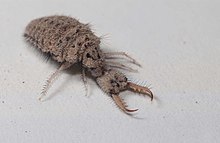
Carabidae
, generally have prognathous headsS–Z
- saltatorial
- adapted for leaping or jumping.
- sarconecrophagy
- feeding on dead bodies of vertebrates.
- sapromycetophagy
- inhabiting decaying matter and consuming mycetes growing inside or cultivating them for feeding.
- saprophagy
- feeding on decaying organic matter.
- scape
- the proximal segment ( antennomere) of the antenna. See Figure 3.
- schisophagy
- feeding on ground remains of plants and animals.
- scolus
- An external spine having multiple points. Etymology: Greek skolos, a prickle. cf. chalaza. plural: scoli
- sensu
- Latin term meaning "in the sense of".
- sequestering
- The process of animals accumulating poisonous compounds from the food they are eating in order to become poisonous themselves for their predators. Pyrrolizidine alkaloid sequestration refers to the sequestration of one such class of poisonous compounds.
- seta
- A stiff chitinous or sclerotised hair or bristle. Also chaeta, cheta
- setaceous
-
- being like or having the nature of a seta or of setae
- setose
- setose
- bearing, or covered in setae.
- setula
- Diminutive of seta. A small chitinous hair or bristle.
- setulose
- bearing, or covered in setulae.
- shade
- see central shade
- trachea.
- sporophagy
- feeding on mycet spores.
- stigma (plural stigmata)
- Prominent cells on the forewings of some moths. Their size, shape and colour can be useful in identifying some species. Also the prominent cell, usually opaque and coloured, near the tip of each wing of the Odonata, on the anterior margin; also called pterostigma.
- strigae
- Patterns with thin lines.
- subcosta
- Taxonomically important term used in Diptera identification keys. Part of the schema of wing venation. The second longitudinal wing vein, posterior to the costa. It may reach the costa, fade before the costa or join R1 before it reaches the costa. see commons:File:Neminidae_wing_veins.svg (= auxiliary vein of many authors)
- subgenal suture
- (Anatomical feature) suture lines below the gena.
symplesiomorphy- a shared ancestral ("primitive") character state that cannot be used to demonstrate the monophyly of a group.
synapomorphy- a shared homologous and derived character state (evolutionary novelty) that demonstrates the monophyly of a group (clade).
- synovigenic
- a form of reproduction in which the female continues to produce and to mature eggs throughout its life cycle.
- tarsus (plural tarsi)
- fifth (last) leg segment, the part that touches the walking surface.
- termen
- The edge of the wing most distant from the body.
- terminal and marginal
- Along the margin.
thorax.- The part of the body that lies between the head and the abdomen. It has three parts - prothorax, mesothorax and metathorax
- tibia
- fourth leg segment, between femur and tarsus.
- tomentum
- a pubescence consisting of soft, entangled hairs pressed close to the surface of the integument.
- tornus / tornal area
- The posterior corner of the wing.
- trochanter
- second leg segment, between coxa and femur.
- trophi
- The mouthparts of Arthropoda such as insects; typically labrum, mandible, maxilla, labium.
- trophus
- The singular form of trophi (rarely used).
- uncate
- hook-like, as in the mouthparts of many fly larvae. (also uncinate)
- uncinate
- hook-like, as in the mouthparts of many fly larvae. (also uncate)
- unguis (plural ungues)
- the claws at the tip of most insect pretarsi.
- urite
- a segment or part of the abdomen in insects.
- urogomphus (plural urogomphi)
- paired "horns" at the posterior tip of the abdomen of larvae.
- urotergite
- plate on the dorsal (upper) surface of an abdominal segment in insects.
- valve
- One of several appendages that combine to form the ovipositor of a typical female insect.
- valvifer
- In female Heteroptera valvifers comprise four blades, one pair on each of abdominal segments 8 and 9. They articulate with the paratergites and bear their corresponding valvulae.
- valvula
- One of four blades in a female Hemipteran with a laciniate type of ovipositor, that combine to form the ovipositing mechanism.
Comstock-Needham system.)- vertex
- (Anatomical feature) The apex of the head, usually containing ocelli.
- villose
- covered with numerous thick-set, slender projections resembling short hairs.
- worker
- Insects within social colonies (bees, wasps, ants, and termites) that usually do not reproduce and instead perform most of the colony's tasks.
- xylomycetophagy
- inhabiting wood and consuming mycetes growing in wood or cultivating them for feeding.
- xylophagy
- feeding on wood.
- zoomycetophagy
- feeding on fungus found on other animals.
- zoophagy
- feeding on animals, and/or animal matter.
Figures
-
Figure 1 Head
Posterior view -
Figure 2 Head
Side view -
Figure 3 Head
Morphology
-
Wing venation Charaxes
-
Wing venation Charaxes
-
Wing venation Acraea
-
Wing venation (in German)
-
Wing and body of a moth (from South Moths of the British Isles)Figure 4
-
Noctuidae WingsFigure 5
See also
- Anatomical terms of location
- Butterfly
- Caterpillar
- Comstock–Needham system
- External morphology of Lepidoptera
- Glossary of ant terms
- Glossary of spider terms
- Glossary of scientific names
- Insect wing
- Pupa
References
- )
- ^ Wigney, Bev (13 March 2007). "a crayfish primer". magickcanoe.com Blog. Ontario. Retrieved 7 December 2017.
the areola (the hourglass shaped lines on the crayfish's "back")
- PMID 16850036.
- ^ Glossary - Integrated Pest Management Resource Centre.
- ^ Atkinson, Thomas H. and Equihua, Armando. "Biology of the Scolytidae and Platypodidae". Florida Entomologist Vol. 69, No. 2 (June 1986)
- ^ Byers, J.A. 1995. "Host tree chemistry affecting colonization in bark beetles", in R.T. Cardé and W.J. Bell (eds.). Chemical Ecology of Insects 2. Chapman and Hall, New York, pp. 154–213
- ISBN 9781402067372
- ^ "reniform, reniform spot". Iowa State University. Archived from the original on 22 July 2016. Retrieved 9 December 2022.
- Evans, W.H. (1932). The Identification of Indian Butterflies (2nd ed.). Mumbai, India: Bombay Natural History Society.
- Thysse, Adrian (2 February 2011). "Ento. 101 – External Structure II: The Head". IPM. p. 1. Retrieved March 5, 2011.
- Gordh G. and D.H. Headrick. A Dictionary of Entomology. Cabi 2001.
- Romoser, William S. The Science of Entomology, pp. 26–49. Collier-MacMillan 1973.
- McAlpine, David K., 1958 A key to the Australian families of Acalptrate Diptera (Insecta) Records of the Australian Museum 24 (12) 183-190 pdf full text and figures
- McAlpine, J.F. 1981 Morphology and terminology In: McAlpine, J.P. et al. (eds.): Manual of Nearctic Diptera vol. 1 Ottawa: Research Branch, Agriculture Canada, Monograph 27. ISBN 0660107317 pdfdownload manual
- Resh, Vincent H. and R. T. Cardé, Eds. Encyclopedia of Insects, pp. 15–19, 750–755. Elsevier 2003.
- Wallace, Robert L. et al. Beck and Braithwaite's Invertebrate Zoology, 4th Ed., pp. 248–250. MacMillan 1989.
- "Insect Morphology". Archived from the original on 2011-03-03.
- http://www.cals.ncsu.edu/course/ent425/library/labs/external_anatomy/anatomy_mouthparts.html Archived 2011-07-20 at the Wayback Machine
- "ENT 425 | General Entomology | Resource Library (Tutorials)".












